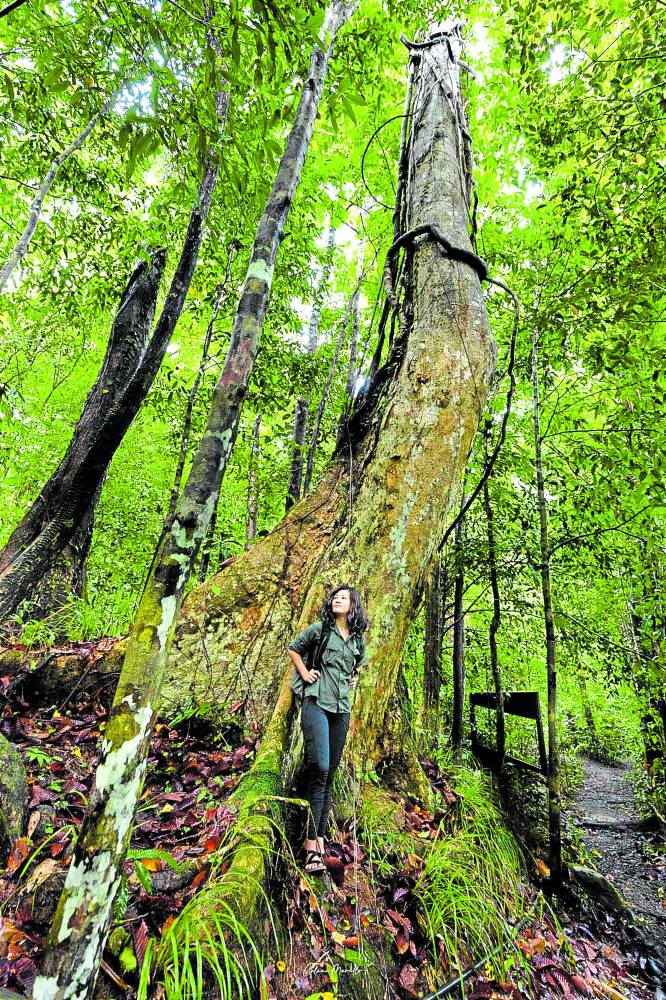Celine Murillo turns over a P5 coin to reveal an embossed image of a Strongylodon macrobotrys, more commonly known as turquoise jade vine, jade vine or the local tayabak. In a short, digestible video, she proceeds to show and tell her followers and subscribers across various social media accounts (currently adding up to over 297,000) about this beautiful flowering plant that is endemic, not just native—and there’s a difference—to the Philippines.
Her Instagram, TikTok, YouTube and Facebook accounts (the latter two of which she shares with her husband Dennis) are full of educational posts about our local biodiversity and natural heritage, along with her travel adventures.
In 2014, her mother’s sudden death prompted Murillo to start traveling. From the loss bloomed a new chapter in her life. To help process her grief, she began blogging about her trips to the mountains and the forests, later on leaning more toward hiking and sustainable and community-based tourism. She would eventually contribute to different publications.
Natural treasures
But it was during the 31-year-old nature photographer and multimedia storyteller’s visit to Masungi Georeserve in 2015, prior to the launch of the foundation, that Murillo said she came to understand how tourism can be truly a force for good.
“People protect the things they love. And loving something begins with getting to know them,” she said. “Education can be empowering—the reception of my work is proof of this. More Filipinos are being ‘reawakened’ to the depth and breadth of our natural treasures, and, my gosh, it’s wonderful!”
According to her, getting to know our natural heritage is also a way to “decolonize” ourselves—a form of resistance to the harmful narrative that “foreign is better” and “humans are the superior species.”
“Our cultural and natural heritage are just as good, and something to be proud of. And we humans are just a few strings in this complex, interwoven, magnificent fabric of life.”

In 2019, in partnership with Biodiversity Finance Initiative and Tamaraw Conservation Program (TCP), Murillo wrote a film titled “Suwag o Suko” as part of a call to institutionalize the TCP and for better compensation for tamaraw rangers.
She got into backyard birding and container gardening during the pandemic, which deepened her appreciation for and connection with the natural world. But when restrictions eased up in 2022, she and her husband packed up, sold most of their possessions and left their Rizal home to travel across the country in a camper van.
In July of that same year, Murillo was chosen by the Asean Centre for Biodiversity to be one of the Young Asean Storytellers, which came with a grant and a trip to the Mt. Kitanglad Range Natural Park in Bukidnon.
Protection advocacy
“There I learned about the richness of the place, coupled with the profound connection of the Talaandig, Bukidnon-Daraghuyan and Higaonon people to Mt. Kitanglad, their ancestral home. That experience moved and inspired me deeply.”
Murillo combines photography, film, poetry and social media to tell stories about the local saribuhay that hopefully spurs fellow Filipinos into advocating for its protection and, at the very least, its science- and sociocultural-based management. She has worked with the Department of Environment and Natural Resources, the Climate Change Commission, the Forest Foundation of the Philippines, Climate Tracker Asia, the United Nations Development Programme and National Geographic.
In 2023, the Revolutionary Storyteller for Photographers Without Borders “sucked it up, despite the millennial cringe,” and started to produce short-form content and got into TikTok to break out of her echo chamber and reach more people “in order to have them share in our ‘rediscovery’ of the wealth of our local biodiversity and natural heritage.”
And because the language of science and conservation can be intimidating, the work of communicators and storytellers like her have become even more imperative: “Science is only truly revolutionary when it reaches the masses, when it is wielded to drive inclusive change.
“By simply empowering fellow Filipinos with accessible, easy-to-understand information about our biodiversity, I hope to help cultivate a nation that is forever in awe and values the natural world, that sees it more than just something to exploit but something to be amazed at and revered,” said Murillo. “And eventually—I have no doubt about this—we can work toward ensuring that the way we live, for example, our laws and policies, will reflect this.” INQ